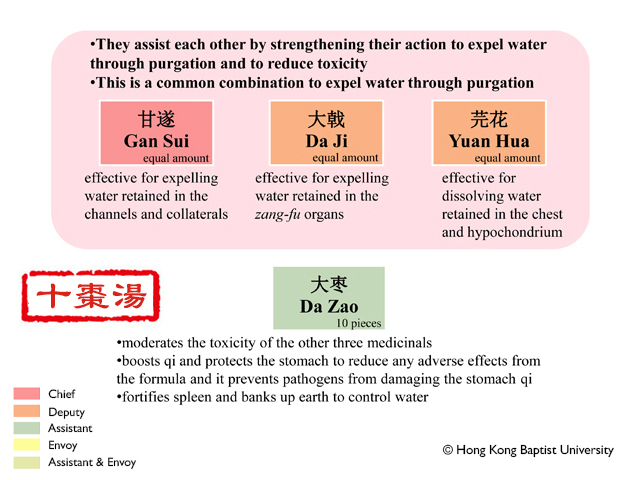| 【Chinese Name】 |
十棗湯
|
| 【Phonetic】 |
Shi Zao Tang
|
| 【English Name】 |
Ten Jujubes Decoction |
| 【Classification】 |
Purgative formulas |
| 【Source】 |
《Treatise on Cold Damage》Shang Han Lun《傷寒論》 |
| 【Combination】 |
Genkwa Flos (Yuan Hua) equal amount, Kansui Radix (Gan Sui) equal amount, Euphorbiae Pekinensis Radix (Da Ji) equal amount |
| 【Method】 |
The three medicinals are ground into powder and then filled into capsules. Take 0.5g to 1g of the capsules with a decoction made of 10 pieces of da zao, one time per day in the morning before breakfast. After defecation, eat porridge to promote recovery. |
| 【Action】 |
Expels water by purgation. |
| 【Indication】 |
This formula is used for pleural rheum with chest and hypochondriac radiating pain caused by coughing and spitting. There is also hardness and distention below the heart, belching, shortness of breath, headache, dizziness, pulling pain resulting in breathlessness, a slippery tongue coating, and a deep and wiry pulse. It is also indicated for edema all over the body, especially in the lower half of the body, with abdominal distention, panting, and difficult defecation and urination. |
| 【Pathogenesis】 |
The types of edema and pleural rheum that can be treated by this formula are caused by excessive water that has accumulated in the chest and rib-side and blocks the movement of qi. This is the reason that there is pain in chest and rib-side with radiating pain caused by coughing and spitting and pulling pain that inhibits deep breathing. Water that is oppressing the lung prevents lung qi from diffusing which causes shortness of breath and coughing. Water that is retained below heart causes qi to stagnate in the center. The stomach’s harmonizing and descending function begins to fail and leads to belching as well as hardness and distention below the heart. Pathogenic fluid obstructs clear yang and inhibits it from rising, which leads to headaches and dizziness. Pathogenic water overflows at the surface in the skin layer and accumulates in the organs, preventing qi from moving freely and causing it to stagnate in the sanjiao. The patient thereby develops systemic edema, abdominal distention, panting, and difficult defecation and urination. A white, watery tongue coating, as well as a deep and wiry pulse are indications of water accumulating in the interior. This type of syndrome cannot be cured by the ordinary method of dissolving rheum and promoting urination; it is necessary to expel water through purgation as fast as possible. |
| 【Application】 |
1. Essential pattern differentiation
Shi Zao Tang serves as the representative prescription used to expel water through drastic purgation and is the most common formula prescribed for pleural rheum and excess edema. This clinical pattern is marked by radiating pain in chest and hypochondrium caused by coughing and spitting, edema, abdominal distention, difficulty in defecation and urination, and a deep, wiry pulse.
2. Modern applications
This formula may be used in the following biomedically defined disorders when the patient shows signs of a pattern of excess water retention in the interior: exudative pleurisy, tuberculous pleurisy, cirrhosis and chronic nephritis causing hydrothorax, ascites, or systemic anasarca and ascites due to terminal schistosomiasis.
3. Cautions and contraindications
First, da ji, gan sui, and yuan hua should be made into powder rather than being decocted with water. Second, the formula should be taken only one time before breakfast in the morning. It should be used temporarily rather than being used for a long time. The dosage is supposed to be small initially. If the water cannot be expelled at the small dosage, then gradually increase the dosage up to 3g. Third, when there is diarrhea after taking it, eat rice porridge to nourish the stomach qi. Last, this formula is only applicable to patients who have sufficient zheng qi and an excess pathogen. Those who are weak or aged should use it with caution. For patients with deficient zheng qi and excess pathogen, the water cannot be drained unless this formula is used in tandem with qi-boosting, spleen-fortifying, and stomach-harmonizing formulas; or sequentially with either supplementation or attacking first. It is important to note that this formula is forbidden to use for those with deficient edema or for those women who are pregnant. |
| 【Additonal formulae】 |
Kong Xian Dan (Drool-Controlling Pill, 控涎丹)
[Source]《Treatise on Diseases, Patterns, and Formulas Related to the Unification of the Three Etiologies》San Yin Ji Yi Bing Zheng Fang Lun《三因極一病證方論》
[Ingredients] Gan sui, da ji and bai jie zi (in the same proportion)
[Preparation and Administration] Grind the medicinals into powder and make them into pills the size of phoenix tree seed. Take 1-3g with warm water in the morning.
[Actions] Dispels phlegm and expels water.
[Applicable Patterns] Phlegm lodged in the chest and diaphragm. Symptoms include: sudden and unbearable, dull pain in the chest, back, neck and hip, pulling and wandering pain in tendons and bone, cold limbs, unbearable headaches, unconscious, fatigue, or sleepiness, poor appetite, sticky saliva, sputum gurgling in the throat at night, profuse drooling, a sticky, greasy tongue coating, and a wiry, slippery pulse. |
|
|




